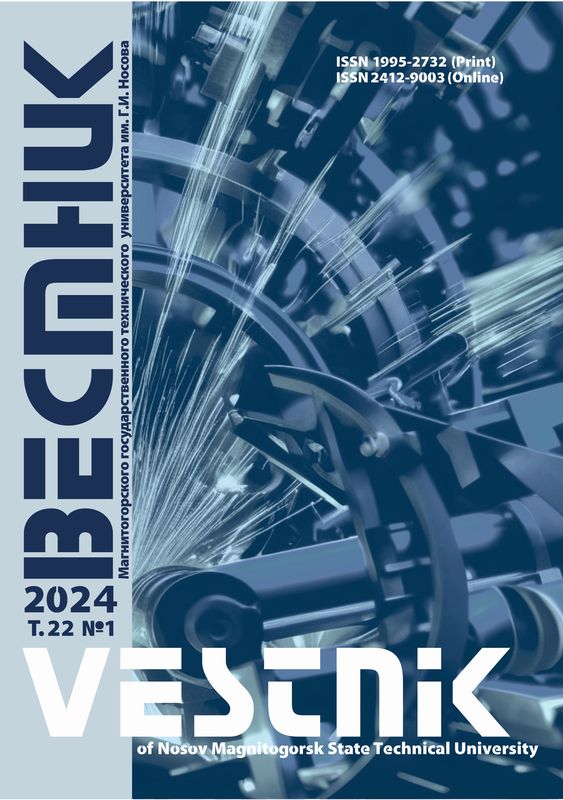DOI: 10.18503/1995-2732-2024-22-1-39-48
Abstract
Problem Statement. Foundry sodium silicate sand cores are still widely used in the iron industrial and art castings due to accessibility and ease of implementation of the sodium silicate sand core-making process as well as safety of components in a core mixture and a gaseous hardener for human health and the environment. Improvement of the sodium silicate sand core-making process involves a search for new additives and compositions of core mixtures, enhancement of methods for curing foundry cores to improve their technical characteristics, physical properties, and performance qualities. During production of metal castings, foundry cores are for a long time exposed to high temperatures, resulting in changes in their technical characteristics and physical properties over time, and influencing the quality of castings. Therefore, determination of temperature dependences for physical and technical characteristics of foundry sodium silicate sand cores based on various compositions is an issue of current interest in science and technology. Objective. The study is aimed at developing an integrated mathematical model describing temperature dependences for physical and technical characteristics of foundry sodium silicate sand cores by improving existing mathematical models, considering results of experimental studies. Method Applied. The authors applied mathematical modeling of temperature dependences for physical and technical characteristics of foundry sodium silicate sand cores at high temperatures during production of metal castings. Originality. The paper presents a proposed mathematical model reflecting temperature dependences for physical and technical characteristics of foundry sodium silicate sand cores, considering promising compositions of core mixtures. Result. The paper demonstrates a possibility of numerical modeling of physical and technical characteristics of foundry sodium silicate sand cores, when choosing a composition for a core mixture to solve a specific problem. Practical Relevance. The paper presented results of numerical experiments using the proposed mathematical model to study physical and technical characteristics of foundry sodium silicate sand cores based on various compositions at high temperatures, considering thermal processes occurring in a foundry mold filled with a molten metallic foundry material with installed foundry cores.
Keywords
foundry core, foundry mold, mathematical model, physical and technical characteristics, core mixture, tensile strength, breakdown, numerical experiment, composition, gas permeability coefficient, outgassing rate, heat capacity, density, thermal conductivity
For citation
Gutko Yu.I., Voytenko V.V. Study on Temperature Dependences for Physical and Technical Characteristics of Foundry Sodium Silicate Sand Cores. Vestnik Magnitogorskogo Gosudarstvennogo Tekhnicheskogo Universiteta im. G.I. Nosova [Vestnik of Nosov Magnitogorsk State Technical University]. 2024, vol. 22, no. 1, pp. 39-48. https://doi.org/10.18503/1995-2732-2024-22-1-39-48
1. Rolf R. Liteynye tekhnologii: Uchebnik [Foundry technologies: textbook]. Nur-Sultan: Foliant, 2019, 408 p. (In Russ.)
2. Holtzer M., Kmita A. Mold and core sands in metalcasting: Chemistry and ecology: Sustainable development. New York City, Dordrecht, Heidelberg, London: Springer, 2020, 378 p.
3. Groover M.P. Fundamentals of modern manufacturing: Materials, processes, and systems. 7th ed. Hoboken, New Jersey, USA: John Wiley & Sons, 2020, 816 p.
4. Heat Transfer Module User’s Guide. Burlington, Massachusetts, USA: COMSOL, 2019, 788 p. Available at: https://doc.comsol.com/5.5/doc/com.comsol. help.heat/HeatTransferModuleUsersGuide.pdf (Accessed on January 27, 2024).
5. Gutko Yu.I., Voytenko V.V. Research of strength and breakdown of foundry liquid-glass cores containing steel powder. Teoriya i tekhnologiya metallurgicheskogo proizvodstva [Theory and Technology of Metallurgical Production]. 2022;(2(41)):12-17. (In Russ.) Available at: http://ttmp.magtu.ru/doc/2022/2/12-17.pdf (Accessed on January 27, 2024).
6. Gutko Yu.I., Voytenko V.V. Studies on breakdown and outgassing rates of foundry sand cores using an organic binder. Nastoyashchee i budushchee sovremennykh nauchnykh napravleniy: Sbornik materialov Mezhdunarodnoy nauchno-prakticheskoy konferentsii [Present and Future of Contemporary Scientific Fields: Collection of papers of the International Scientific and Practical Conference]. Kemerovo: West Siberian Scientific Center, 2022, pp. 70-73. Available at: https://www.sibscience-new.ru/images/ doc_temp/2022/Sbornik_13_06_22.pdf (Accessed on January 27, 2024).
7. Gutko Yu.I., Voytenko V.V. Research of breakdown of foundry liquid-glass cores. Nastoyashchee i budushchee sovremennykh nauchnykh napravleniy: Sbornik materialov Mezhdunarodnoy nauchno-prakticheskoy konferentsii [Present and Future of Contemporary Scientific Fields: Collection of papers of the International Scientific and Practical Conference]. Kemerovo: West Siberian Scientific Center, 2021, pp. 14-17. Available at: https://www.sibscience-new.ru/ images/doc_temp/18_05.pdf (Accessed on January 27, 2024).
8. State Standard GOST 28840-90. Mashiny dlya ispytaniya materialov na rastyazhenie, szhatie i izgib. Obshchie tekhnicheskie trebovaniya [Machines for tension, compression, and bending testing of materials. General technical requirements]. Moscow: Izdatelstvo standartov, 2004, 8 p. (In Russ.) Available at: https://meganorm.ru/Data2/1/4294852/4294852156.pdf (Accessed on January 27, 2024).
9. State Standard GOST 10580-2006. Oborudovanie tekhnologicheskoe dlya liteinogo proizvodstva. Obshchie tekhnicheskie usloviya [Technological equipment for foundry. General technical conditions]. Moscow: Izdatelstvo standartov, 2009, 23 p. (In Russ.) Available at: https://meganorm.ru/Data/56/5694.pdf (Accessed on January 27, 2024).
10. State Standard GOST 23409-78. Peski formovochnye, smesi formovochnye i sterzhnevye [Moulding sands, moulding and core sand mixtures]. Moscow: Izdatelstvo standartov, 1995, 3 p. (In Russ.) Available at: https://meganorm.ru/Data2/1/4294830/4294830675.pdf (Accessed on January 27, 2024).
11. Tyutina E.A. Razrabotka tekhnologii polucheniya legkovybivaemykh zhidkostekolnykh sterzhnevykh smesey: dis. … kand. tekhn. nauk [Development of the technology for producing of easily knocked out sodium silicate core mixtures. PhD thesis]. Komsomolsk-on-Amur, 2006, 173 p. (In Russ.)
12. Vargaftik N.B. Spravochnik po teplofizicheskim svoystvam gazov i zhidkostey [Handbook of thermo-physical properties for gases and liquids]. Moscow: Nauka, 1972, 720 p. (In Russ.)
13. Chirkin V.S. Teplofizicheskie svoystva materialov: Spravochnoe rukovodstvo [Thermophysical properties of materials: reference guide]. Moscow: Fizmatgiz, 1959, 356 p. (In Russ.)
14. Codina R. Comparison of some finite element methods for solving the diffusion-convection-reaction equation. Computer Methods in Applied Mechanics and Engineering. Amsterdam: Elsevier, 1998;156:185-210. DOI: 10.1016/S0045-7825(97)00206-5.












